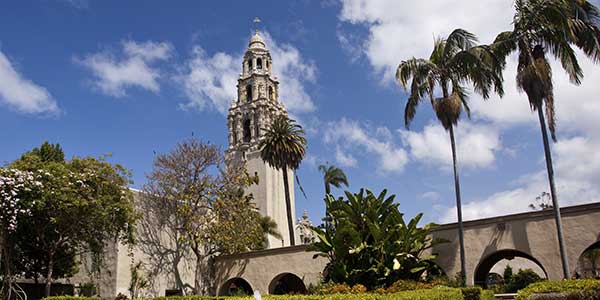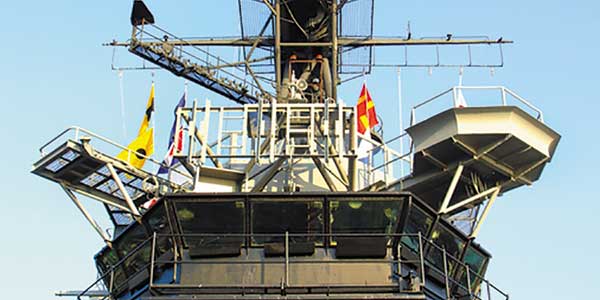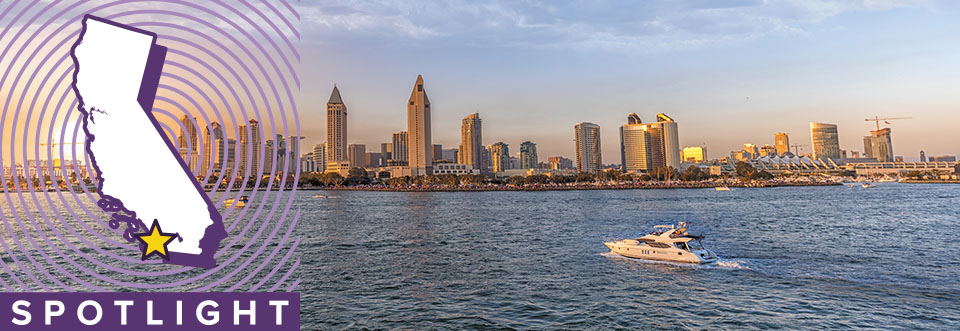San Diego
Visit a SoCal town that brims with recreation and history
It’s easy to fall for San Diego. More than just a family-friendly Southern California beach town with a longevity-boosting climate, San Diego is a state of mind. Innovation and adventure underpin the city’s rampant development, and there’s no shortage of hot new night spots, award-winning restaurants and break-the-mold architecture.
From the glorious Balboa Park — the nation’s largest urban cultural park and home to 17 fine museums — to hipster beach communities, the world-famous San Diego Zoo and the Victorian Gaslamp Quarter, San Diego knows how to fully inhabit and grace the moment. Join the fun in this scenic and sophisticated city.
Balboa Park
Distinguished for its architecture and landscape design, Balboa Park is a destination unto itself. Often hailed as one of the world’s finest parks, this 1,200-acre expanse features world-class museums, the award-winning Old Globe Theater, playgrounds, the Japanese Friendship Gardens, and one of the nation’s best zoos. Along El Prado, the park’s main east-west axis, the resplendent buildings borne of two World Fairs (1915-16, 1935-36) provide home to a stellar repository of artifacts at the Natural History Museum, the Air & Space Museum, and the Museum of Man.
Lovers of wide-open spaces revel in the park’s luxuriant gardens, laced with walking trails and home to superb outdoor performance spaces. Several shops and restaurants can be found in and around the park, and its proximity to Interstate 5 makes it easily accessible.

Torrey Pine State Natural Reserve
From a lofty clifftop position overlooking the Pacific Ocean, this wild and rugged 1,500-acre coastal park provides sanctuary to the Torrey pine. North America’s rarest species of pine tree, the Torrey pine survives along this strip of coast by virtue of sandy, stony soils and the lingering spring and summer fog that compensates for low rainfall. Naturalists, bird watchers and novice hikers are drawn to the park’s wild topography, with maritime chaparral, mile after mile of pristine beaches, sculpted sandstone, magnificent wind-whipped pines twisted into surreal formations and a lagoon that nurtures migrating seabirds.
The short and sweet Razor Point Trail (just over half a mile) traverses coastal sage scrub before forking to the Yucca Point Overlook where the sword-shaped leaves of yucca plants bloom in the spring and honeycomb-patterned sculptures called tafoni — the result of sandstone erosion — can be seen. Hikers are rewarded with superb ocean views, while pods of bottlenose dolphins and whales draw gasps from cliff- top onlookers during the winter. A short drive to the north, the laid-back beach community of Del Mar is a great place to relax on an ocean shore. Travelers seeking action can bet on the horses at the Del Mar Thoroughbred Club racetrack. Also in town, the Del Mar Fairgrounds host the San Diego County Fair every June and July.
La Jolla
The aptly named “jewel” of San Diego’s northern coast, you don’t need to linger long in La Jolla before you feel as though you have fallen into the silver screen. There’s more than a whiff of Hollywood romance to this pretty and poised village draped over a wild 7-mile stretch of coastline. La Jolla boasts all the haute culture trappings of a metropolis. There’s an award-winning theater, a world-class fine art museum and a confection of late 19th century Craftsman-style beach cottages that overlook the Pacific. Down below, colonies of harbor seals nonchalantly go about their business in the Children’s Pool. Sandwiched between the hip boutiques and eclectic stores of downtown La Jolla and the dramatic coastline, a stroll through the palm-fringed Ellen Browning Scripps Park reveals California’s emblematic coastal scenery. Below the water, the San Diego-La Jolla Underwater Park spans 6,000 acres of ocean bottom and tidelands riddled with sea caves, kelp beds and a rocky reef that provides refuge to an array of colorful marine life.
Old Town San Diego
History lovers will appreciate the city’s historic Old Town, a gorgeous neighborhood at the intersection of Interstate 5 and Interstate 8 that’s full of beautiful and historic mission-style buildings, lots of excellent restaurants (many with great Mexican food), a theater and plenty of quaint shops.
Weekends are an especially good time to visit, when local craftspeople descend upon the Old Town Harney Street Market to sell their wares. Other popular special events include the annual Cinco de Mayo celebrations (held on a weekend closest to May 5), a Day of the Dead festival, and the annual Taste of Old Town, which is dedicated to highlighting the neighborhood’s culinary specialties.
Old Town is a feast for history buffs. Old Town’s core of restored original historic buildings is complemented by reconstructed sites, and the early 20th-century buildings boast designs in the same vein. The historic plaza remains a gathering place for community events and historic activity. Five original adobe buildings are part of the state historic park, which includes museums, unique retail shops and several restaurants.
San Diego is also home to one of the missions established in the 18th century by the iconic Spanish priest Father Junipero Serra. Still standing is the Mission Basilica San Diego de Alcalá, California’s first mission church. The mission was founded in 1769; today, it still serves an active congregation. Over the years, it has been renovated to resemble its 18th-century grandeur.
Hotel Del Coronado
A cultural attraction as well as a place to go on a grand shopping spree, the Hotel del Coronado still draws the international traveling set in the same way as it did when it first opened in 1888. Combining style and substance, the legendary hotel was the brainchild of a couple of entrepreneurial Midwesterners: Elisha Babcock and Hampton Story. The pair purchased land on the Coronado Island in 1885 with the vision of building a stately Victorian-style hotel on the beach. With its whimsical turrets, cone-shaped pavilion and grand lawns, it’s an elegant and enchanting slice of Victoriana as well as a beloved national icon. In addition to providing accommodations, the hotel also houses several shops along with restaurants.
The Victorian building offers the best and most eclectic accommodation options, while the modern California Cabana buildings and Ocean Towers are plush in design. Beyond the grounds of the hotel, the island serves as a resort city within San Diego County.
It seems as though Coronado Island’s entire mission in life is to indulge in the moment. There are several recreational opportunities, which include a biking/walking path that orbits the island, a pristine beachfront and a vibrant downtown strip with fine restaurants and shopping. The island is connected to San Diego via the graceful Coronado Bay Bridge.
San Diego Zoo
The world-famous San Diego Zoo is in a class of its own. Balboa Park’s most lauded attraction, the 100-acre complex provides home to over 3,500 animals that dwell within enchanting, sensitively conceived natural habitats that allow for intimate viewing opportunities. An accredited botanical garden, the flora in the zoo is a remarkable collection of more than a million imported specimens, including exotic plants and rare species. Zoo founder Harry Wegeforth traveled the world in search of his creatures, and made it his mission to gather samples of flora along with each species he acquired.
Lovers of pachyderms should stampede to the Elephant Odyssey, with its compelling herd of Asian elephants. The extensive Monkey Trails and Forest Tales is a lush wooded forest with an elevated canopy trail that allows for close encounters with endangered species, including the mandrill monkey and pygmy hippopotamus. Other rare species living at the zoo include long-billed kiwis from New Zealand, lowland gorillas from Africa, giant pandas (the zoo is one of only four in the US with resident pandas) and giant tortoises from the Galápagos Islands. While most in-shape visitors opt to tour on foot, convenient open-air buses provide insightful, guided 40-minute, three-mile tours of most of the animal exhibits. The Skyfari Aerial Tram also furnishes excellent panoramas of the park and is a worthy induction to the zoo’s layout.
San Diego Zoo Safari Park
One of the closest things you can get to an African safari, the San Diego Zoo Safari Park adjunct of the San Diego Zoo provides sanctuary to more than 400 (many endangered) species from across the globe, including giraffes, antelopes and rhinos. Sprawling more than 1,800 acres of the San Pasqual Valley (35 miles north of San Diego), the park’s naturally landscaped preserves replicate each animal’s natural habitat in Africa and Asia and allows the creatures to interact as they would in the wild. Only the elephants, tigers, lions, and cheetahs are restricted to enclosures, while all the other animals can be seen roaming free through the valley and bounding along the sprawling grounds. Predator species are separated by moats.
As well as the hugely popular Lion Camp and Elephant Overlook, there’s a petting station and an amphitheater with educational and interactive presentations. If you have sufficient time and energy, there are several self-guided, themed walking tours. To cover the expansive grounds in a more expedient fashion, you can rent a Segway or hop on the excellent 2.5-mile Africa tram safari, which zips you around the park in 25 minutes.
Gaslamp Quarter
History and hedonism coalesce in downtown San Diego’s Victorian Gaslamp Quarter, a hip and happening 16-square block enclave that stretches from Broadway to Harbor Drive and encompasses Fourth, Fifth and Sixth avenues. Founded in the 1850s, the area assumed notoriety for its sin and vice, with brothels and gaming halls pocking its seedy, ramshackle streets. The area finally cleaned up its act in the 1980s when the district’s decaying Victorian architecture was saved from the wrecking ball and placed on the National Register of Historic Places.
Nowadays, the neighborhood has been reborn as the poster child for cosmopolitan élan. A confection of Victorian buildings nudge up against soaring skyscrapers that house an eclectic range of fine restaurants, sleek bars, fashionable nightclubs, art galleries and retail therapy for every dispensation. Tables spill out on the sidewalks, rooftop lounges serve designer cocktails, fine dining restaurants draw accolades from across the nation, and everything from live jazz to authentic blues competes for the attention of revelers each night.
Themed explorations of the Gaslamp Quarter include historic tours, Segway tours, food tours, beer tours and fashion tours. With its extravagant holiday parades, it’s worth timing a visit according to the robust festival calendar, especially the riotous Mardi Gras Fat Tuesday parade, St. Patrick Day ShamROCK festival, Fallback Festival for children and the tongue-in-cheek Gaslamp Holiday Pet Parade, when owners and their pets dress up as each other.

USS Midway Aircraft Carrier
A must-see sight on the San Diego Bay waterfront, the aircraft carrier USS Midway’s impressive half-a-century tenure in the United States Navy included combat roles in the Vietnam War and Operation Desert Storm before it was decommissioned in 1992 and began its enterprising new role as a floating naval-aviation museum in 2004. Visitors enter the 1,001-foot-long Midway on the carrier deck, where the planes were housed before and after each sortie.
Here, some 30 vintage restored
aircraft are displayed, including a SBD Dauntless Dive Bomber from WWII, a Vietnam-era Huey gunship helicopter, an F-14 Tomcat fighter, an F-4 Phantom jet fighter and a rare F4F Wildcat. More than 60 interactive exhibits include two flight simulators, a multi-media show on the World War II Battle of Midway, and several cockpits that kids can explore. A highlight of the tour, visitors can negotiate the constricted passageways of the upper deck and then check out the admiral’s war room and the tower, where you can sit in the chair where the captain would survey aircraft as they took off and landed on the flight deck.
Anza-Borrego
A thrilling drive north from San Diego, the Anza-Borrego Desert State Park is California’s largest state park. During spring, when Technicolor wildflowers erupt across the desert floor, the crowds descend en masse. But, regardless of the season, the park humbles with its scale (600,000 acres) and antiquity; archaeologists trace human activity in Anza-Borrego back more than 6,000 years.
Indeed, there are few better places to lace up hiking boots. Framed by the chiseled mountains of the Bucksnorts and the Santa Rosas to the north, the Jacumba Mountains to the south, and the Vallecito and Pinyon mountains to the west, more than 100 miles of hiking trails (for all levels) traverse washes, palm groves, and clusters of hirsute cacti. Around 500 miles of dirt roads (all open to cyclists) ascend craggy hills, negotiate deep sands, funnel along scenic streams, and plummet down steep hills.
The Pacific Crest Trail dips in and out of the park at numerous intervals providing 50 miles of hardcore hiking for adventurous souls keen to make their heart valves squeak. Wildlife may bet glimpses of roadrunner, golden eagles, kit foxes, mule deer and bighorn sheep. Reptiles here include iguanas, chuckwallas and red diamond rattlesnakes.
For More Information
San Diego Tourism Authority
619-232-3101
www.sandiego.org
California Tourism
877-225-4367
www.visitcalifornia.com







